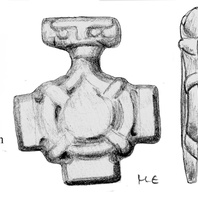
Viking Objects
Die Stamp (NLM-690F57)
This cast copper-alloy die was used in the process of making filigree pendants of the Hiddensee-Rügen type, more specifically, to create pressed silver or gold sheet appliqués, which were applied to a pendant back-plate and used as a base for filigree and granulation work. The ring in the centre creates a closed ring-knot motif related to the Scandinavian Borre style. The Hiddensee-Rügen style is named after the gold jewellery hoard discovered in the late nineteenth century on the island of Hiddensee, off the Baltic coast of Germany. The Swinhope die is one of a small group of recorded objects used in the production of Hiddensee-style cruciform pendants. No finished pendants of the type represented by the Swinhope die are known, either from England or Scandinavia.
Read More
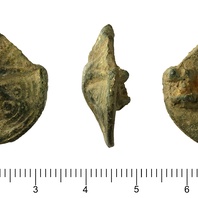
Viking Objects
Copper-Alloy Borre-Style Brooch (SWYOR-A257A6)
A Scandinavian copper-alloy Borre-style convex disc brooch decorated with three inward-looking Borre-style animal heads separated by wedge-shaped arms. Identified as Jansson type II A1 by Jane Kershaw. For more information on Scandinavian jewellery in England check out our blog: Brooches, Pendants and Pins: Scandinavian Dress Accessories in England.
Read More
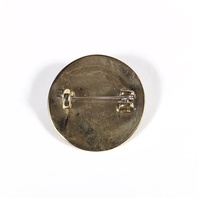
Viking Objects
Reproduction Silver Terslev Brooch
Terslev style, where Scandinavian ring-chain patterns are the main decorative component, is a subcategory of the Borre style and takes its name from the silver hoard discovered in Terslev, Denmark. The decoration comprises a series of ring-knots related to the Borre ring-chain. The Terslev style occurs mainly on brooches and pendants, including both high-quality gold and silver jewellery as well as lower-end base metal items. The cast-base metal jewellery, such as those made of copper alloy, were intended to imitate the higher-end gold and silver jewellery, and often employed techniques such as gilding to achieve this. The Terslev designs that occur in England extend the repertoire by introducing new Scandinavian motifs hitherto unrecorded in Scandinavia. For more information on Scandinavian jewellery in England check out our blog: Brooches, Pendants and Pins: Scandinavian Dress Accessories in England.
Read More
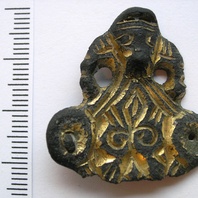
Viking Objects
Equal-Armed Brooch (SWYOR-50BAF5)
A fragment of a Viking Age equal-armed brooch found at Harworth Bircotes, Nottinghamshire. This fragment is the terminal of the brooch and resembles brooches found at Birka, Sweden. Its decoration consists of a Borre style animal with gripping arms or legs. This is one of only six Scandinavian, Viking period equal-armed brooches recorded in England. For more information on Scandinavian jewellery in England check out our blog: Brooches, Pendants and Pins: Scandinavian Dress Accessories in England.
Read More
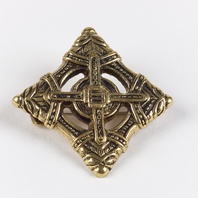
Viking Objects
Reproduction Lozenge Brooch
A copper alloy lozenge brooch in the Borre style based off a find in Lincolnshire. This type of brooch was common throughout the Danelaw in the Viking Age and was used as an accessory by women who wore Scandinavian dress. Scandinavian brooches came in a variety of sizes and shapes which included disc, trefoil, lozenge, equal-armed, and oval shapes. The different brooch types served a variety of functions in Scandinavian female dress with oval brooches typically being used as shoulder clasps for apron-type dresses and the rest being used to secure an outer garment to an inner shift. Anglo-Saxon brooches do not match this diversity of form with large disc brooches being typical of ninth century dress styles with smaller ones becoming more popular in the later ninth and tenth centuries. However, since disc brooches were used by both Anglo-Saxon and Scandinavian women they are distinguished by their morphology. Scandinavian brooches were typically domed with a hollow back while Anglo-Saxon brooches were usually flat. Moreover, Anglo-Saxon brooches were worn singly without accompanying accessories.
Read More
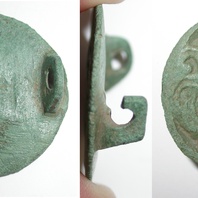
Viking Objects
Borre Style Brooch (DENO-805B20)
This copper-alloy brooch is an example of Kershaw’s East Anglian series and is decorated with interlaced Borre-style designs. For more information on Scandinavian jewellery in England check out our blog: Brooches, Pendants and Pins: Scandinavian Dress Accessories in England.
Read More
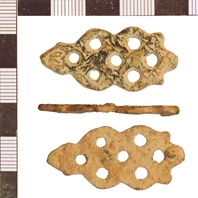
Viking Objects
Anglo-Scandinavian Mount (NLM-491EBD)
This copper-alloy mount is decorated with an openwork plate interlace ornamentation in possible Borre style.
Read More
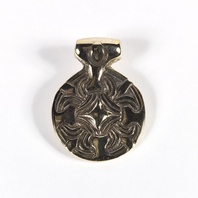
Viking Objects
Reproduction Terslev Pendant
Terslev style, where Scandinavian ring-chain patterns are the main decorative component, is a subcategory of the Borre style and takes its name from the silver hoard discovered in Terslev, Denmark. The decoration comprises a series of ring-knots related to the Borre ring-chain. The Terslev style occurs mainly on brooches and pendants, including both high-quality gold and silver jewellery as well as lower-end base metal items. The cast base-metal ornaments, such as those made of copper alloy, were intended to imitate the higher-end gold and silver jewellery, and often employed techniques such as gilding to achieve this. The Terslev designs that occur in England extend the repertoire by introducing new Scandinavian motifs hitherto unrecorded in Scandinavia. For more information on Scandinavian jewellery in England check out our blog: Brooches, Pendants and Pins: Scandinavian Dress Accessories in England.
Read More
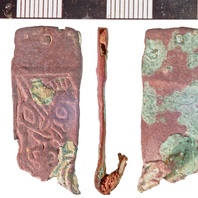
Viking Objects
Borre-Style Strap-End (NLM-F4E3D9)
This strap-end is classified as a Thomas Class E type 4 with Borre-style decoration. Strap-ends came in various styles and were fairly common throughout the Viking world. They were used to decorate the ends of belts and to stop them getting damaged.
Read More
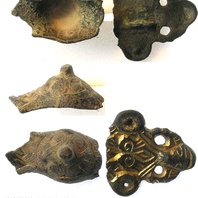
Viking Objects
Fragment of an Equal-Armed Brooch (SWYOR-FAFC04)
A fragment of a Viking Age equal-armed brooch found at Harworth Bircotes, Nottinghamshire. This fragment is the boss of the brooch and resembles brooches found at Birka, Sweden. Its decoration consists of a Borre style animal with gripping arms or legs. This is one of only six Scandinavian, Viking period equal-armed brooches recorded in England. For more information on Scandinavian jewellery in England check out our blog: Brooches, Pendants and Pins: Scandinavian Dress Accessories in England.
Read More
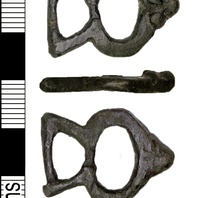
Viking Objects
Buckle Frame (DENO-98937A)
This copper-alloy buckle frame has a pin rest of zoomorphic form with two widely spaced rounded ears and a rounded snout. It has been classified as a Thomas Class B Type 4 buckle and the decoration is classed as Borre style.
